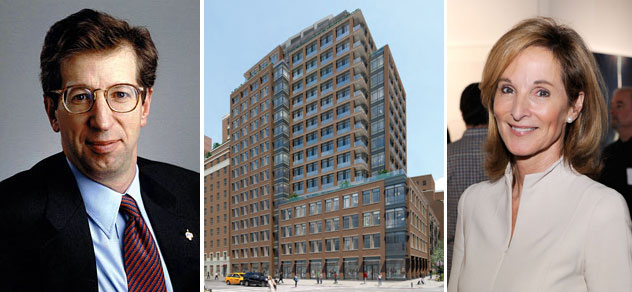Trending
Rudin all but rules out affordable housing at St. Vincent’s conversion, despite demands from community officials

From left: William Rudin, CEO of Rudin Management, a rendering of Rudin’s conversion of the St. Vincent’s hospital canvas, and Planning Commissioner Amanda Burden
Developer William Rudin said the “economics” of his company’s $1 billion conversion of the St. Vincent’s hospital campus into a 450-unit luxury residential development could not support affordable housing, as he came under fire from community officials for not doing enough to justify a requested rezoning of the Greenwich Village site.
Rudin, the CEO of Rudin Management, appeared today at the first public hearing in the uniform land use review procedure, or ULURP, to decide whether the developer can proceed with the controversial project, already four years in the making. As City Planning commissioners peppered speakers with questions, some members of an overflow crowd of neighborhood residents, community officials and construction union members in orange shirts heckled the developer, calling him a liar.
Rudin is seeking city approval for zoning changes and special permits, primarily to allow for higher residential density, new ground-floor retail uses, and a 152-space underground parking garage at the project. The proposal includes 450 LEED-certified condominiums reportedly priced at $2,000 per square foot, plus 11,200 square feet of retail, a 564-seat elementary school and a 15,000-square-foot public space on the so-called St. Vincent’s Triangle.
“If you look at the site today, what you see is a void in the fabric of Greenwich Village,” Rudin said.
While Rudin maintained that the development balanced community services with the necessity of obtaining financing, Angela Battaglia, a City Planning commissioner, said that a “nice balance” would include a commitment to providing affordable housing.
David Reck, chair of the land use and development committee at Community Board 2 — whose members voted overwhelmingly against the proposal — urged the developer to build affordable units on-site. But he said the board would also welcome off-site affordable units, and added that there are properties in Greenwich Village where this would be feasible.
“We’re really getting a very large project that’s going to be a burden on the community, and they’re not doing enough to compensate for it,” Reck said, noting that rezoning the hospital campus would double its value. “Why should we go along with that?”
Rudin, who allowed that he would consider “creative ideas” for developing off-site affordable housing, maintained that the project would provide numerous benefits to the community, starting with hundreds of millions of dollars in tax revenue. “We think this project has reached a level of public contribution that exceeds even our expectations when we started the conversation,” he said.
To alleviate community concerns over the closure of St. Vincent’s, which shuttered last year after filing for bankruptcy protection, Rudin Management has pledged a building valued upwards of $30 million, plus a $10 million investment, for a freestanding emergency care facility operated by North Shore Long Island Jewish Health System. “This is the type of model that will deliver quality healthcare at a reasonable cost to the community,” Rudin said.
However, when Commissioner Irwin Cantor asked a NSLIJ representative about how the facility would handle gunshot wounds and other acute injuries, City Planning Commission Chair Amanda Burden interrupted to say the facility was not part of Rudin’s zoning application.
Earlier, community representatives — including aides for New York State Assembly member Deborah Glick and noted real estate attorney Albert Butzel — expressed concerns about allowing a private developer to take advantage of a parcel of buildings originally zoned for public services.
The city approved the current zoning in 1979, giving the hospital additional height and floor area allowances in recognition of its designation as a community facility.
Approving Rudin’s proposal, warned Andrew Berman, executive director of the Greenwich Village Society for Historic Preservation, would open a “deeply troubling Pandora’s box,” that could allow developers across the city to exploit similar facilities for extra density. “This is wrong, not just for this site, but for the city as a whole,” he said.
Still, Rudin appears to have a backup option that hinges on roughly 160,000 square feet of development rights associated with the Triangle. Under the current proposal, Rudin Management has committed to effectively extinguishing those development rights, but if the proposal is not approved, it could use those rights to build an even larger project, said Melanie Meyers, a Fried Frank partner who is advising the developer.
Rudin has already won two key approvals. The Landmarks Preservation Commission signed off on the current proposal in 2009, and last week Manhattan Borough President Scott Stringer granted approval with certain conditions. Earlier this month, Stribling & Associates opened the first on-site sales office.
Community members also voiced concerns that the planned parking garage will increase traffic in the area, and that ground-floor retail would affect the residential character of 11th and 12th streets.




